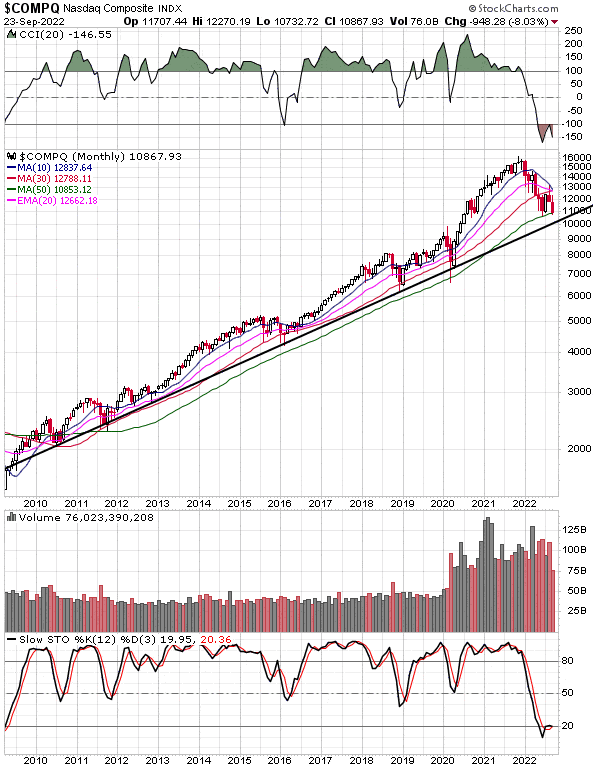Don’t Fight the Fed… Or Trend… Or Trend in the Fed
In a recent blog post and alerts we talked about how important it has been to recognize a key pattern in 2022. This is how it goes:
First the Fed raises interest rate and/or balance sheet contraction expectations, the market drops 10% or more quickly, they then back off and maybe hint that future interest rate expectations have peaked, the market starts to regain traction, and then they raise the bar again. Another market selloff starts soon after.
A move from 1% to 2% future interest rate expectations to 5.5% or more all at once last November would have crashed the market right away. This raising the bar every few weeks or so deflates bubbles more slowly.
Last week we witnessed it again. This time the Fed reduced economic growth expectations for next year and put 75 basis point rate hikes solidly on the table for the next 2 Fed meetings in November and December.
Future interest rate expectations increased again and the market dropped around another 5% within a couple trading days after the Wednesday announcement and press conference.
Although no one is mentioning it, a former Fed governor floated the idea of not 4.6% but perhaps 5.5% by early next year which makes sense with the current trailing core PCE inflation.
What Worked Last Week
Most of our top trading opportunities featured to customers over the past couple weeks have been short opportunities. A much higher CPI number a couple weeks ago sparked a sell-off and also gave the Fed the opportunity to get even more hawkish.
One of the simplest trades we had was a short on the SPY a week and a half ago. This A-B-C down pattern developing had a target around the June lows. The SPY reached the entry point a week and a half ago and reached our profit target on Friday.
Other shorts on stocks have done well so far also. Again, the trend is your friend if you make it your friend by trading in the current direction of the market.
As always, we tend to take more off in that initial 5% to 15% profit range and tighten our stop on the remainder when volatility is this high as explained in our swing trading primer.
Big Long Opportunities Next?
Eventually the selling will lead to great long opportunities. If selling does not accelerate in October, we will see some great companies beat earnings expectations and raise guidance. This could lead to some great short-term swing trades on stocks above a rising 200 day moving average.
Similar to what we saw last quarter with stocks like ENPH and SWAV right after earnings.
When Will the Market Bottom?
A great question that no one really knows the answer to.
When swing trading, however, the real question to ask is which way is the market currently trending? And is there a new catalyst?
If its trending lower with a catalyst, we then ask which stocks have the worst long-term trends, fundamental factors and most bearish consolidation patterns. We then wait for a good short technical entry point on more bad news.
If the market is trending lower, we focus more on short swing trades than during a bull market or market uptrend.
If the market is trending higher, we focus of stocks with the best long-term trends, best fundamental factors and bullish consolidation patterns. We then look for a good technical entry point on more good news.
A lot of the work involves analyzing the current trends and getting a list of top stocks for a trade in either direction.
Signs of a Market Bottom
Ok, so we already discussed why swing traders often don’t care when the market bottoms.
However, one of the good signs is when negative news no longer drives the market lower. So, perhaps it will be another big rate hike or bad inflation number followed by only a small move to the downside or strong rebound.
Perhaps it will be once the unemployment rate starts to spike higher and PMI numbers fall apart. Some say it will be 2/3 of the way through a recession. But who really knows?
We will continue to mostly trade in the direction of the current trend, even if its just going long in a sustained bear market rally.
Trend lines going back to 2009
Longer-term, we are still above the trend-lines defined by the lows over the past 13 years believe it or not. Another 5% to 10% lower from here and we will be testing those long-term trend-lines. So on a monthly chart, a longer-term timeframe, its still a long-term uptrend.
Chart courtesy of StockCharts.com
Notice the long-term trend-lines line up nicely with the pre-pandemic high. This is also the case for the S&P 500. Around 3400 for the S&P currently. This also matches up with forecasts made by top analysts based on their valuation measures. The ones that have been right so far this year.
So perhaps we will see a strong rebound starting once we reach or go a little below those trend-lines. Perhaps not. Time will tell and there is no need to be a hero trading and try to time a bottom exactly.
We will just look for the classic signs of a new market uptrend starting and trade more long if we see them near these long-term trend-lines.
One of the big differences between buy and hold and swing trading is that when swing trading you need to see signs the trade is moving strongly in the direction of the trade. We want the market averages to be trending in our direction as well.
But either way, we will be trading more in the direction of the current intermediate-term trend until the market indices confirm a new uptrend. Lets hope its a big signal off the long-term trend-lines above.
Our Top Longs and Shorts for the Weeks Ahead





